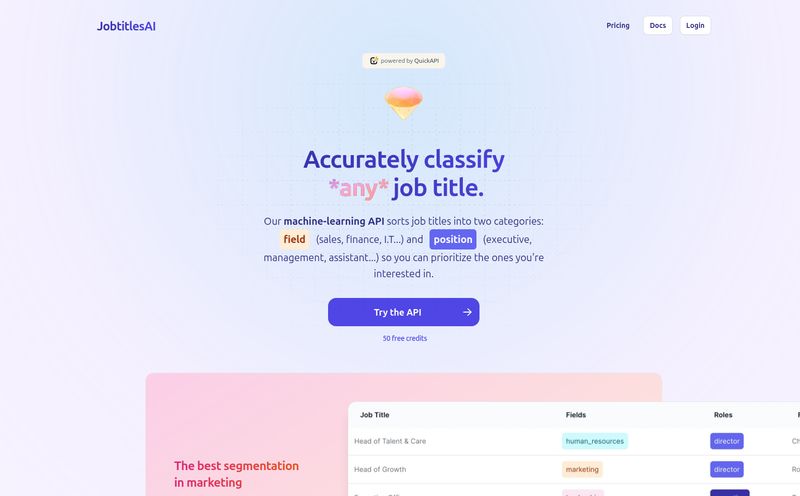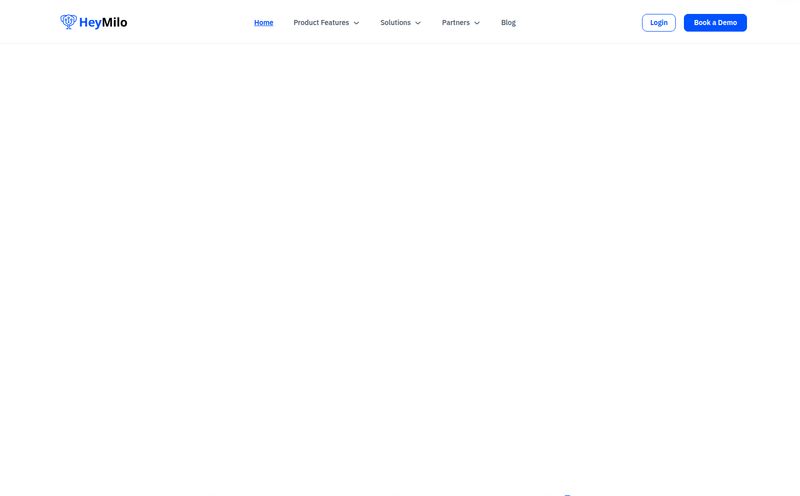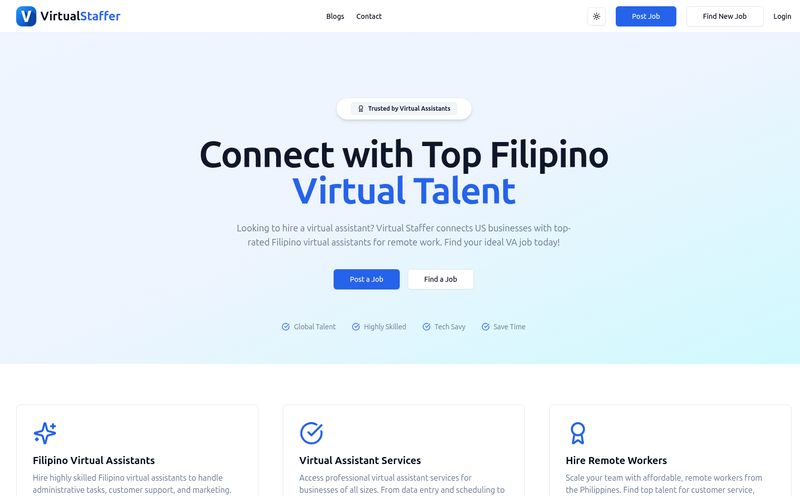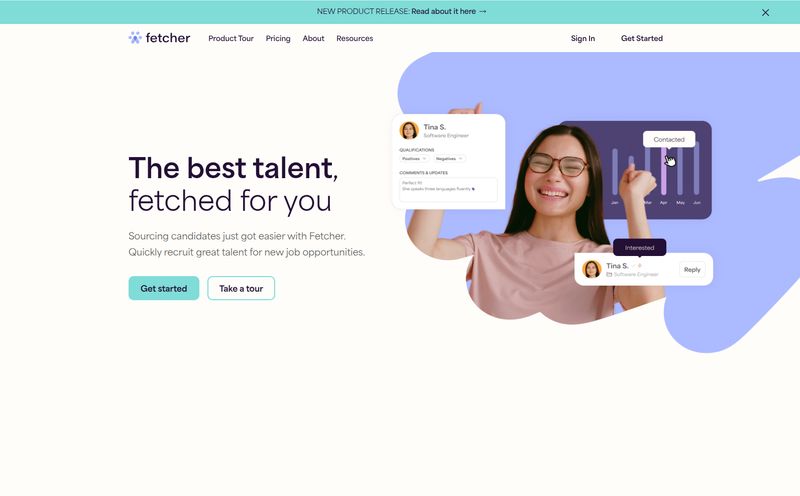Is This the End of the Résumé Black Hole?
Job hunting can be a soul-crushing numbers game. You spend hours tailoring your résumé, you write a cover letter that you think is pure poetry, and you send it off... into the void. Crickets. You do it again. And again. It feels like you’re just feeding a giant, faceless machine—the dreaded Applicant Tracking System (ATS)—that’s programmed to say “no.” I’ve been in the SEO and traffic game for years, and even I get chills thinking about the sheer algorithmic brutality of modern hiring.
We're told to “stand out,” but how? When you're just one of 300 PDF attachments, standing out feels impossible. But what if you could change the game entirely? What if, instead of just telling a company you’re good at your job, you could show them exactly what you’d do in your first 90 days? That’s the wild premise behind a new tool that recently landed on my radar: Sentimetric.
I’m naturally skeptical of anything that promises to be a silver bullet, especially in the job market. But I have to admit, this one got my attention. It’s not another résumé builder. It's something different. It’s a tool designed to turn your application from a passive plea into an active, strategic proposal. And I’m kinda here for it.
So What Exactly Is Sentimetric?
Okay, let's break it down. Sentimetric is an AI-powered platform that helps you create a detailed, custom presentation for a specific job at a specific company. Think of it less like a résumé and more like a consultant's pitch. It's your secret weapon for showing a hiring manager that you haven't just read the job description, you've actually thought about their business.
The process is surprisingly straightforward. You feed the AI information about yourself (your skills, your experience) and information about the company you’re targeting (their website, their mission, recent news, the job listing itself). Then, the magic happens. Sentimetric analyzes all that data and spits out a presentation complete with:
- A summary of the company's current state.
- Custom project ideas that you, with your specific skillset, could implement to help them.
- A full SWOT analysis (Strengths, Weaknesses, Opportunities, Threats) for your proposed projects.
Essentially, you’re walking into the interview (or even the initial application stage) with a ready-made plan. You’re not just a candidate; you're a problem-solver from day one. It’s a power move, and in this market, we need all the power moves we can get.
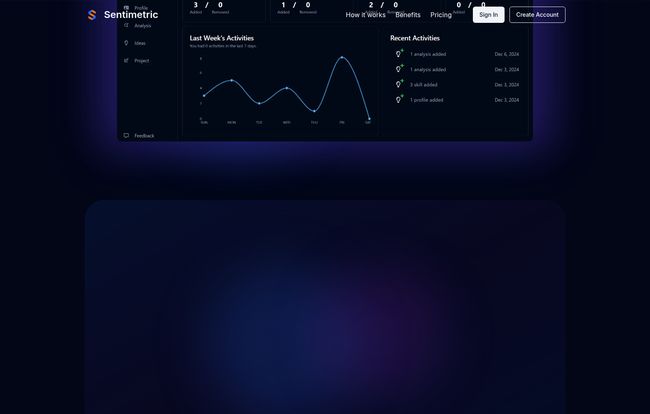
Visit Sentimetric
A Peek Behind the Curtain: The Sentimetric Workflow
I took the tool for a spin to see if it was as simple as it claimed. The whole thing is broken into a few clear steps that take you from zero to a full-blown strategic proposal in—and they claim this—less than half an hour. For me, it was about 25 minutes for the first one, so they’re not far off.
Step 1: The Dream Job Profile
First, you set up your profile. This is where you list your skills, experience, and the kind of role you're aiming for. Pretty standard stuff, but it's teh foundation for everything that comes next.
Step 2: The Company Deep Dive
This is where it gets interesting. You give Sentimetric the company name and any other info you can find—a link to their ‘About Us’ page, a recent press release, the job description, whatever. You basically act as its research assistant, and the more you give it, the better the output. The AI then goes to work, trying to understand the company’s goals, values, and potential pain points.
Step 3: Ideas and Analysis
After a few minutes of chomping on data, the platform presents you with a company summary and a list of potential project ideas. For a marketing role, it might suggest things like “Revamp the SEO strategy for underperforming blog content” or “Launch a targeted social media campaign for X product.” Each idea is tailored to connect your skills to their needs. And this is where it produces that killer SWOT analysis for each project. It's like having a tiny business strategist in your pocket.
Step 4: The One-Click Presentation
Once you choose the projects you want to highlight, you click a button, and voila. Sentimetric generates a text-based presentation, weaving everything together into a coherent narrative. It explains who you are, what you understand about their company, and here’s a concrete plan for how you can add value. It's pretty impressive stuff.
The Good, The Not-So-Bad, and The AI-Powered Reality
No tool is perfect, right? So let’s get into the nitty-gritty. What works and what should you keep in mind?
Where Sentimetric Is a Game Changer
The biggest win here is the time saved and the shift in positioning. Researching a company properly to this level would take hours. Sentimetric automates the grunt work, freeing you up to focus on the strategy. It also completely reframes your application. You’re no longer just asking for a job; you’re demonstrating immediate value. In my experience, that's the fastest way to get a hiring manager’s attention and justify a higher salary negotiation.
It’s also incredibly empowering for career changers. If you’re trying to break into a new industry, your past experience might not look like a perfect fit on paper. But a Sentimetric presentation can bridge that gap by showing exactly how your existing skills are transferable and can be applied to their problems.
A Few Caveats and Considerations
Now, for a dose of reality. The effectiveness of Sentimetric hinges on the quality of your input. It's a classic “garbage in, garbage out” scenario. If you give it a vague job title and a single link to a homepage, the results will be generic. You still need to do some legwork to find good source material for the AI.
Some might also argue that relying on an AI could stifle your own creativity. I see that point. However, I view it differently. I don't see Sentimetric as the final product, but as an incredible first draft. It’s the ultimate brainstorming partner. It gives you the structure and the data-backed ideas, and then you can come in and sprinkle your own human personality and nuance on top. You’re still the architect; the AI is just your super-advanced power tool.
Let's Talk Money: The Sentimetric Pricing Plans
Alright, the all-important question: what’s this going to cost? The pricing structure is actually one of the things that impressed me most because it feels accessible to pretty much anyone. They have three tiers.
I've laid them out in a table to make it easy to compare, because who has time to squint at website screenshots?
| Plan | Price | Key Features |
|---|---|---|
| Free | $0 / month | 1 company profile, 2 partial analyses, AI summary, 3 project ideas, 800-word presentation, SWOT analysis. Perfect for a test drive. |
| Subscription | $19 / month | 10 company profiles/month, 5 analyses per company, 6 project ideas per company, 1200-word presentations. Great for an active job search. |
| Lifetime Access | $39 (one-time) | Unlimited everything, basically. All the features of the subscription plan, but you just pay once and have it forever. |
Honestly? That $39 Lifetime Access deal is a bit of a no-brainer if you're serious about your career. In an industry where some professional development tools cost hundreds, getting lifetime access to something this practical for less than the price of a nice dinner is an absolute steal. Even the free plan is generous enough to let you create one full presentation to see if you like the workflow.
Final Thoughts: Is Sentimetric Your Next Hire?
So, is Sentimetric the magic wand that will instantly land you a six-figure job? No, of course not. Nothing is. But it is a powerful tool that can give you a significant, almost unfair, advantage in the job market.
Job hunting has evolved. It’s no longer about just having the right skills; it's about communicating your value effectively. Tools like Sentimetric represent a shift from passive applications to proactive, strategic engagement. It helps you fight the ATS dragons and get your ideas in front of a real human.
If you’re tired of sending your résumé into the abyss, I’d say give the free version a shot. What have you got to lose? You might just find it's the secret weapon you've been looking for to finally cut through the noise.
Frequently Asked Questions
- 1. Is Sentimetric just for tech or marketing jobs?
- Not at all! While it's a natural fit for roles where strategy is obvious, you could use it for almost any professional job. An operations manager could propose a new efficiency workflow. A non-profit manager could propose a new fundraising campaign. It's about showing initiative, which is valued everywhere.
- 2. How much can I customize the final presentation?
- The AI generates a text-based presentation. You can, and absolutely should, copy this text and put your own finishing touches on it. Edit the language to sound more like you, format it in a way you like, and add your own insights. Think of the AI output as a 90% complete draft.
- 3. Will this actually guarantee me an interview?
- There are no guarantees in life or job hunting. However, it dramatically increases your chances of standing out from the hundreds of other applicants who just submitted a standard résumé. It shows effort, intelligence, and genuine interest, which is what hiring managers are desperate to see.
- 4. How long does the analysis actually take?
- The AI analysis part is surprisingly quick, usually just a few minutes. The whole process, from inputting your info to getting a finished presentation draft, can realistically be done in under 30 minutes, especially after you've done it once.
- 5. Is that $39 lifetime deal for real?
- As of my writing this, yes. It's listed on their site as a special offer. Deals like this in the SaaS world don't always last forever, so if you're interested, it's probably one to jump on sooner rather than later.
Reference and Sources
- Sentimetric Official Website & Pricing: https://www.sentimetric.net
- Harvard Business Review Article on Proactive Job Searching: Why the Best Way to Find a Job Is to Be Proactive
